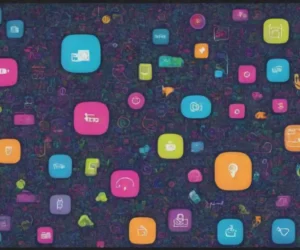
Advanced Conversational AI Techniques by ChatGPT

- Advanced Machine Learning Techniques for Training ChatGPT
- Incorporating Natural Language Processing Algorithms
- Utilizing Deep Learning Models
- Implementing Reinforcement Learning
- Integrating Sentiment Analysis
- Applying Transfer Learning
- Employing Attention Mechanisms
- Using Generative Adversarial Networks
- Implementing Memory Networks
- Incorporating Context-Awareness Techniques
Advanced Machine Learning Techniques for Training ChatGPT
ChatGPT leverages advanced machine learning techniques to enhance its conversational abilities. These techniques ensure the model remains accurate, relevant, and responsive.
Supervised Fine-Tuning
Supervised fine-tuning involves training ChatGPT on a curated dataset of high-quality conversations. This process refines the model's responses, ensuring they are accurate and contextually appropriate. During fine-tuning, the model learns from human-provided examples, improving its ability to generate coherent and relevant answers.
Reinforcement Learning
Reinforcement learning (RL) is used to further refine ChatGPT's performance. In RL, the model is trained through interactions with users or simulated environments, receiving feedback on its responses. This feedback is used to adjust the model's parameters, optimizing for more effective and natural conversations.
Continual Improvement
Continual improvement is achieved by regularly updating the model with new data and feedback. This ongoing process ensures ChatGPT remains up-to-date with current language usage, trends, and user expectations, enhancing its ability to provide accurate and timely responses.
Automating Software Testing with Machine Learning and NLPExample of Reinforcement Learning
Here's an example of a reinforcement learning loop in Python:
import random
# Sample conversation data
conversations = [
{"input": "Hi, how are you?", "response": "I'm good, thank you! How can I help you today?", "reward": 1},
{"input": "What's the weather like?", "response": "I don't know.", "reward": -1},
# More conversation samples...
]
# Simple reinforcement learning loop
for epoch in range(10):
for convo in conversations:
user_input = convo["input"]
generated_response = generate_response(user_input) # Function to generate response
reward = convo["reward"]
adjust_model(generated_response, reward) # Function to adjust model based on rewardIncorporating Natural Language Processing Algorithms
Natural Language Processing (NLP) algorithms are integral to ChatGPT's ability to understand and generate human-like text.
Understanding Context with NLP
Understanding context is crucial for meaningful conversations. NLP techniques help ChatGPT grasp the nuances of a conversation, identifying key elements like entities, intents, and sentiments. This understanding allows the model to generate more relevant and context-aware responses.
Enhancing Language Comprehension
Enhancing language comprehension involves using NLP algorithms to parse and interpret complex language structures. This capability enables ChatGPT to understand and respond to a wide range of queries accurately, from simple questions to intricate discussions.
Exciting Machine Learning Projects to Spark Your InterestImproving Response Generation
Improving response generation is achieved through advanced NLP techniques that help the model produce coherent and contextually appropriate replies. This involves generating text that not only answers the user's question but does so in a natural and engaging manner.
Handling Ambiguity and Uncertainty
Handling ambiguity and uncertainty is a key challenge in NLP. ChatGPT uses probabilistic models to manage these situations, providing the most likely and contextually relevant responses even when faced with vague or ambiguous queries.
Example of Context Understanding
Here's an example of using NLP to understand context in Python:
import spacy
# Load NLP model
nlp = spacy.load("en_core_web_sm")
# Sample text
text = "ChatGPT is developed by OpenAI and it's quite advanced."
# Process text
doc = nlp(text)
# Extract entities and context
entities = [(ent.text, ent.label_) for ent in doc.ents]
print(f'Entities: {entities}')Utilizing Deep Learning Models
Deep learning models enhance ChatGPT's conversational abilities by enabling it to understand and generate complex language patterns.
Complete Guide to End-to-End Machine Learning ProjectsEnhancing Natural Language Understanding (NLU)
Enhancing NLU involves using deep learning models to improve the model's ability to understand user inputs. These models analyze the syntax and semantics of the text, enabling ChatGPT to comprehend and respond accurately.
Generating Contextually Rich Responses
Generating contextually rich responses is made possible by deep learning architectures like transformers. These models can generate text that maintains coherence and relevance over longer conversations, providing users with meaningful interactions.
Adapting to User Preferences and Style
Adapting to user preferences and style involves training the model to recognize and mimic individual user styles and preferences. This personalization enhances user engagement and satisfaction.
Continuous Learning and Improvement
Continuous learning and improvement are achieved by regularly updating the model with new data and feedback. This keeps ChatGPT aligned with current language trends and user expectations.
Writing Data for Machine Learning AlgorithmsExample of Deep Learning for NLU
Here's an example of enhancing NLU using a deep learning model in Python:
import tensorflow as tf
from transformers import TFBertModel, BertTokenizer
# Load model and tokenizer
model = TFBertModel.from_pretrained('bert-base-uncased')
tokenizer = BertTokenizer.from_pretrained('bert-base-uncased')
# Sample text
text = "ChatGPT can understand and generate human-like text."
# Tokenize and encode text
inputs = tokenizer(text, return_tensors='tf')
# Get model output
outputs = model(inputs)
print(outputs)Implementing Reinforcement Learning
Reinforcement learning (RL) is crucial for improving ChatGPT's responses through feedback-driven training.
How Reinforcement Learning Works
Reinforcement learning involves training ChatGPT by allowing it to interact with users or environments and receive feedback on its responses. This feedback is used to adjust the model's parameters, optimizing its conversational abilities.
Benefits of Reinforcement Learning
Benefits of implementing reinforcement learning include improved accuracy, relevance, and naturalness of responses. RL allows the model to learn from mistakes and successes, continuously enhancing its performance.
Exploring Machine Learning: Exciting .NET Projects to Try OutExample of Reinforcement Learning Application
Here's an example of applying reinforcement learning with Python:
import random
# Sample rewards for different responses
responses = {"good_response": 1, "bad_response": -1}
# Simple reinforcement learning function
def reinforcement_learning(response):
reward = responses.get(response, 0)
update_model(response, reward) # Function to update model based on reward
# Function to simulate user interaction
def simulate_interaction():
user_input = "Hello!"
generated_response = generate_response(user_input) # Function to generate response
reinforcement_learning(generated_response)
simulate_interaction()Integrating Sentiment Analysis
Sentiment analysis enables ChatGPT to understand and respond to the emotions conveyed in user messages.
Understanding Emotions
Understanding emotions is key to empathetic and effective communication. Sentiment analysis allows ChatGPT to detect positive, negative, and neutral sentiments, tailoring its responses accordingly.
Enhancing User Experience
Enhancing user experience involves using sentiment analysis to provide emotionally appropriate responses, improving user satisfaction and engagement.
Deep Generative ClusteringExample of Sentiment Analysis
Here's an example of implementing sentiment analysis in Python:
from textblob import TextBlob
# Sample text
text = "I'm feeling great today!"
# Perform sentiment analysis
blob = TextBlob(text)
sentiment = blob.sentiment
print(f'Sentiment: {sentiment}')Applying Transfer Learning
Transfer learning allows ChatGPT to leverage pre-existing knowledge, enhancing its ability to learn new tasks efficiently.
Leveraging Pre-Trained Models
Leveraging pre-trained models involves using models trained on large datasets as a starting point for new tasks. This approach reduces training time and improves performance by utilizing existing knowledge.
Enhancing Learning Efficiency
Enhancing learning efficiency through transfer learning enables ChatGPT to adapt quickly to new domains and tasks, improving its versatility and robustness.
Example of Transfer Learning
Here's an example of applying transfer learning with Python and transformers:
from transformers import TFBertForSequenceClassification, BertTokenizer
# Load pre-trained model and tokenizer
model = TFBertForSequenceClassification.from_pretrained('bert-base-uncased')
tokenizer = BertTokenizer.from_pretrained('bert-base-uncased')
# Fine-tune model for a specific task
def fine_tune_model(texts, labels):
inputs = tokenizer(texts, return_tensors='tf', padding=True, truncation=True)
model.compile(optimizer='adam', loss='sparse_categorical_crossentropy', metrics=['accuracy'])
model.fit(inputs['input_ids'], labels, epochs=3)
texts = ["I love this!", "I hate that!"]
labels = [1, 0]
fine_tune_model(texts, labels)Employing Attention Mechanisms
Attention mechanisms help ChatGPT focus on relevant parts of conversations, improving the coherence and relevance of responses.
Enhancing Focus
Enhancing focus involves using attention mechanisms to identify and emphasize key parts of the input text, ensuring the most important information is used in generating responses.
Improving Coherence
Improving coherence with attention mechanisms ensures that responses are contextually relevant and maintain the flow of conversation, enhancing user experience.
Example of Attention Mechanisms
Here's an example of using attention mechanisms with Python and transformers:
from transformers import TFBertModel, BertTokenizer
# Load model and tokenizer
model = TFBertModel.from_pretrained('bert-base-uncased')
tokenizer = BertTokenizer.from_pretrained('bert-base-uncased')
# Sample text
text = "ChatGPT uses attention mechanisms to focus on important parts of the conversation."
# Tokenize and encode text
inputs = tokenizer(text, return_tensors='tf')
# Get model output with attention
outputs = model(inputs, output_attentions=True)
print(outputs.attentions)Using Generative Adversarial Networks
Generative Adversarial Networks (GANs) can enhance the quality of ChatGPT's responses by generating more realistic and varied text.
Benefits of GANs
Benefits of using GANs in ChatGPT include improved response quality and diversity. GANs consist of two neural networks, a generator and a discriminator, that work together to produce high-quality outputs.
Example of GAN Application
Here's an example of a simple GAN setup in Python:
import tensorflow as tf
# Define generator model
generator = tf.keras.Sequential([
tf.keras.layers.Dense(128, activation='relu', input_shape=(100,)),
tf.keras.layers.Dense(256, activation='relu'),
tf.keras.layers.Dense(512, activation='relu'),
tf.keras.layers.Dense(784, activation='sigmoid')
])
# Define discriminator model
discriminator = tf.keras.Sequential([
tf.keras.layers.Dense(512, activation='relu', input_shape=(784,)),
tf.keras.layers.Dense(256, activation='relu'),
tf.keras.layers.Dense(1, activation='sigmoid')
])
# Compile models
discriminator.compile(optimizer='adam', loss='binary_crossentropy', metrics=['accuracy'])
discriminator.trainable = False
gan = tf.keras.Sequential([generator, discriminator])
gan.compile(optimizer='adam', loss='binary_crossentropy')
# Train GAN (placeholder code, actual training loop needed)
# gan.fit(...)Implementing Memory Networks
Memory networks enable ChatGPT to retain information during conversations, enhancing its ability to provide contextually relevant responses over extended interactions.
How Memory Networks Work
Memory networks store and retrieve relevant information from past interactions, helping the model maintain context and continuity in conversations.
Benefits of Memory Networks
Benefits of using memory networks include improved coherence and relevance in extended conversations, as the model can remember previous inputs and responses.
Example of Memory Networks
Here's an example of a simple memory network setup in Python:
import tensorflow as tf
from tensorflow.keras.layers import Embedding, LSTM, Dense, Input
# Define memory network
inputs = Input(shape=(None,))
memory = Embedding(input_dim=10000, output_dim=64)(inputs)
memory = LSTM(64)(memory)
output = Dense(1, activation='sigmoid')(memory)
# Compile model
model = tf.keras.Model(inputs, output)
model.compile(optimizer='adam', loss='binary_crossentropy', metrics=['accuracy'])
# Train model (placeholder code, actual training data needed)
# model.fit(...)Incorporating Context-Awareness Techniques
Context-awareness techniques make ChatGPT more responsive to the conversation at hand, improving its ability to provide relevant and accurate responses.
Understanding Context
Understanding context involves using techniques to maintain the flow and coherence of the conversation. This includes recognizing the topic, intent, and sentiment of user inputs.
Dynamic Response Generation
Dynamic response generation allows ChatGPT to adapt its responses based on the context, ensuring they are relevant and meaningful. This enhances the overall user experience.
Benefits and Applications
Benefits and applications of context-awareness include improved user satisfaction, more engaging conversations, and the ability to handle complex interactions effectively.
Example of Context-Awareness
Here's an example of incorporating context-awareness in Python:
class Chatbot:
def __init__(self):
self.context = []
def update_context(self, user_input):
self.context.append(user_input)
def generate_response(self, user_input):
self.update_context(user_input)
response = self.create_response_based_on_context()
return response
def create_response_based_on_context(self):
# Placeholder for actual context-aware response generation logic
return "This is a context-aware response."
# Usage
bot = Chatbot()
print(bot.generate_response("Hello!"))
print(bot.generate_response("How are you?"))Advanced conversational AI like ChatGPT utilizes a variety of machine learning techniques to enhance its performance. From supervised fine-tuning and reinforcement learning to deep learning and memory networks, these techniques ensure that ChatGPT remains accurate, context-aware, and capable of engaging in meaningful conversations. By incorporating NLP algorithms, sentiment analysis, attention mechanisms, and context-awareness, ChatGPT can provide high-quality, personalized responses that enhance user experience.
If you want to read more articles similar to Advanced Conversational AI Techniques by ChatGPT, you can visit the Applications category.



You Must Read